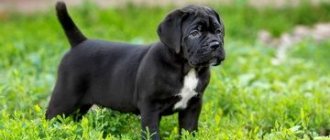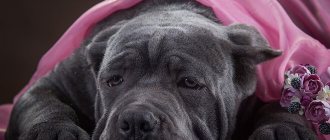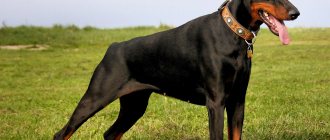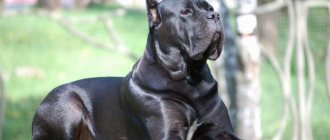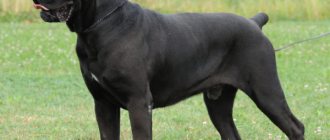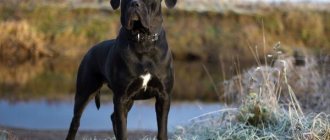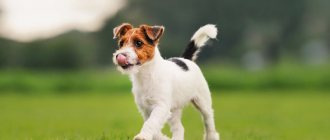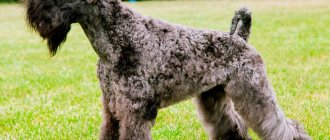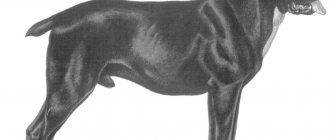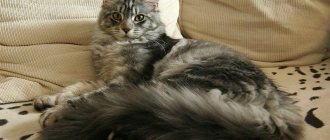Based on the totality of all its qualities, the Cane Corso can be called a universal dog. It belongs to those breeds that, despite fashion trends, remain at the peak of popularity. Breeders and owners note that she:
- retained the fighting spirit, unshakable perseverance and extraordinary strength of her ancestors;
- shows aggression only when necessary;
- perfectly “scans” and interprets gestures, facial expressions and behavior of others and reacts to them based on the complexity of the situation;
- has good security qualities;
- loves to fuss with the owners' children and tolerates their excessive display of affection;
- scares away intruders with one appearance;
- charming and sociable, doesn’t mind communicating with all family members;
- multifunctional - can be a watchman, a shepherd and a pleasant companion;
- easily trains, does everything that the owner requires of her;
- unpretentious in content.
The breed has thicker skin than other Molossians. The thick-skinned Corso loves to roll in a puddle, dig in the ground, and swim in the river. She doesn't mind putting her paws in a bowl of water. Of course, she can be weaned off this. It is more difficult to cope with excessive salivation, night snoring, daytime grunting and sniffling. If these sounds irritate you, this breed is not for you.
Brief characteristics of the Cane Corso dog breed
Male:
Bitch:
Price:
Life expectancy: 10–11 years, rarely lives up to 12 years. |
How difficult is the Cane Corso breed to maintain and care for? | Representatives of the Italian Cane Corso dog breed are easy to care for. She does not require exhausting loads, is clean, and, with proper upbringing, is non-aggressive. Can be both a companion and a working dog. |
Do you feel comfortable in an apartment or prefer a country house? Do you need an aviary? | Despite its large size, it is suitable for apartments and country houses. But the enclosure is not suitable for her. The breed requires constant contact with humans. In addition, people from warm Italy do not tolerate our winters well. If you decide to build an enclosure, make a warm booth in it. |
How often should you bathe? | If the pet does not participate in exhibitions, it is washed as needed, usually 2-4 times a year. A healthy dog has sebaceous glands that create a protective film on the coat. From frequent washing, the protection is washed away, and the glands hypertrophy. As a result, the coat becomes faded and greasy. |
Grooming. How often is it brushed? | This is a short-haired breed. But she still sheds. If you want to reduce the frequency of house cleaning, brush your Cane Corso regularly, especially during periods of heavy shedding. |
Is it suitable for a child? | The breed is well suited for families even with the smallest children. The pet patiently endures all the pranks of the kids. However, it requires firmness in education. It can be used by children aged 12–14 years. |
Frequency and duration of walks | The animal will be healthy and cheerful if you take it out for a walk for 1.5–2 hours every day. This is a powerful dog that needs exercise. In winter, she will happily take the children on sledding rides; in summer, she will play with a ball and run after fetch items. |
The playfulness of the Cane Corso | The breed is playful and pet friendly. |
Attitude towards family members, strangers, other animals | The owner for her is a king and a god rolled into one. The dog is friendly towards all family members. Be wary of strangers. Gets along well with other animals. |
Pet diseases
Despite all their power and physical strength, Cane Corso can be susceptible to serious illnesses.
Among the main pathologies are the following diseases::
- pelvic dysplasia is the most common disease for this breed of dog, which can be hereditary;
- allergies to various external influences and food;
- pathologies of the thyroid gland;
- chronic bloating or acute dilatation of the stomach;
- eye problems – entropion, ectropion, cherry eye;
- epilepsy.
The etiology of diseases may have genetic roots, but most often the causes are associated with poor nutrition, excess weight, lack of proper maintenance, excessive and too early physical activity.
CAREFULLY!
It should be remembered that active jogging for dogs is indicated starting from 1-1.2 years, but not earlier.
When choosing a puppy, it is important to find out its hereditary predispositions.
Advantages and positive assessment when choosing this breed
- The Cane Corso is an excellent watchdog. The pet will protect property and owners from uninvited guests.
- The dog is smart and disciplined, easy to train. She quickly grasps what her owner requires of her and tries to quickly carry out commands.
- Easy to train.
- The breed looks impressive and intimidating. With such a companion it is not scary to walk even in the most disadvantaged area.
- Corso is affectionate and obedient to its own people, distrustful of strangers, and poses a serious threat to them.
- Grooming for representatives of the breed is minimal: combing the coat during shedding, active walking and feeding.
- The animal becomes strongly attached to one owner.
Disadvantages of the breed
- Requires active walking. A leisurely half-hour walk on a leash will not be enough for her. A young individual can damage things in the house if left alone for a long time.
- This is a large breed, in the education of which relaxation is unacceptable. You need to train your puppy from an early age.
- Puppies require early socialization. Representatives of the breed are naturally distrustful of strangers. If you don't want to lock your dog up every time guests, a plumber or a mechanic comes, start training it as early as possible.
- An animal makes various sounds in its sleep (snoring, sniffling), which can be unpleasant if kept in an apartment.
- High price. Not everyone can afford to buy a purebred puppy. And crossbreeds and puppies from unplanned matings can have health problems.
Pros and cons of the breed
| Advantages | Flaws |
|
|
|
|
|
|
|
|
|
|
| |
|
Cane Corso: dog character
According to the description of the Cane Corso breed, it has a typical Molosser character. It has the following features:
- mental balance is predictable, she does not have sudden outbursts of aggression, she knows how to wait for a command;
- boundless devotion to the owner - with proper upbringing, even a three-year-old child can command a huge dog;
- strong guard qualities - the character is genetically based on the desire to protect the perimeter of a house, apartment, yard, and reacts severely to the appearance of strangers, however, a well-trained dog always lets go of the victim if it stops moving or the owner’s command is heard;
- a combination of external equanimity and playful temperament - they are actively involved in the game, young Corsos may not even hear the owner’s commands, but adult dogs behave sedately, their endurance can be envied;
- dependence of character on color - breeders note that gray individuals are more aggressive, like representatives of the brindle breed. They have a more domineering character.
Behavior at home
He gets along with all the inhabitants in the house. She usually gets along with children and other pets. This trait has deep roots. She was adopted back when Corsos were herding dogs. Since then they have been trying to establish contact with other representatives of the fauna. Even if the older pet shows aggression, the Corso will patiently wait for a reason to make friends with him.
The owners note that the Corso can be a nanny for small children. However, such a teacher should not be left unattended with the baby. And don’t forget to teach your children how to behave around a dog.
Behavior on the street
The herding past left another imprint on the character of the Cane Corso: she loves to patronize. If the family decides to go on a picnic, the pet will do everything possible to ensure that no one gets lost. He will always keep his “herd” under control. At the same time, he has no jealousy or selfishness, which is rare for Molossians.
Attitude towards strangers, protection of the owner and home
Well-trained adults react calmly to passers-by, strange dogs and other animals. This breed has retained the ability to evaluate the slightest changes in the behavior of others. If they begin to behave aggressively, the Corso turns from an easy-going companion into an angry protector.
Usually, if the owner is friendly to the stranger, she also behaves calmly. Her usual position is between the owner and the stranger. She watches every move, not letting anyone forget about herself.
However, poorly behaved dogs may not allow strangers near their owner and may attack cyclists, runners, and passers-by. Pets with whom they don’t walk a lot can behave the same way. A bored animal becomes irritable. Your pet will find something to do without you, but you are unlikely to like it.
Brief description and character
For this versatile dog, close communication with its owner is important. An emotional connection with him is almost in the first place.
The pet also treats other family members with special warmth, especially if there are children in the house
The emotional connection with him comes almost in the first place. The pet also treats other family members with special warmth, especially if there are children in the house.
But the owner occupies a fundamental place in the life of dogs of this breed.
The breed is characterized by excellent memory and intellectual abilities; Corso dogs get along well with other pets, in addition, they begin to patronize them and take patronage over them.
If there are other dogs in the house, conflicts between them are extremely rare.
Aggression can occur towards other dogs of the same sex as the Cane Corso, and this trait is especially pronounced in young and teenage dogs.
CAREFULLY! Despite the fact that these Italian dogs get along well with children, it is still not worth leaving your small infant, or even older children, alone with a pet.
A baby may unconsciously cause discomfort to the dog, to which it may respond with spontaneous aggression.
This remark applies more to males, who are a little more aggressive, more active and louder than females. Females are softer, more compliant and patient.
The protective properties of the breed are manifested already at a young age; this trait is characteristic of the Cane Corso as a dominant one.
The territory in which the dog lives will be under its careful supervision, and aggressive qualities appear after a year, when the dog gets stronger physically.
There is no point in making a dog angry on purpose, since the psyche of a young dog becomes unbalanced and such traits as aggression and hot temper predominate.
Care and maintenance
The existing characteristics of the Cane Corso breed and reviews from experienced dog breeders allow us to conclude that with proper walking, the Corso will feel good in any living space. Year-round keeping outside is not recommended. If the animal is in an enclosure in winter, it needs to be provided with a warm place to sleep. This is a short-haired breed. She has a small undercoat, but it will not keep her warm in cold weather. The Corso is also not suitable for the role of a chain dog. He has too great a desire to communicate with people and a very freedom-loving character.
Grooming
The dog does not need haircuts. From time to time it is simply combed out with a special brush. Wool does not have an unpleasant specific odor. The pet does not create discomfort for the inhabitants of the house. It is washed several times a year. The rest of the time, the coat is cared for by wiping it with a rubber brush or a damp towel.
Nail care
An actively walking dog does not need to have its nails trimmed. She wears them down during walks. It is enough to keep them clean by wiping their paws with a damp cloth after going outside. But if you hear a characteristic clicking sound on the floor, you will have to give her a pedicure using special tweezers.
Eyes and ears
According to the standard, the lower eyelid should not be too saggy. If your pet's eyes are excessively wet, you need to make sure that there are no discharge or crusts in the corners of the eyes. Healthy ears do not smell and are always clean.
According to the breed standard, dropped and cropped ears are allowed. In our country, docking is allowed. It is better to do this before 4–5 months of age. Please note that in most countries this operation is prohibited, and dogs with cropped ears cannot participate in international exhibitions held in their territory.
Teeth
If the owner adheres to the recommended diet, then there should be no problems with teeth. Check your pet's teeth from time to time and give him treats to combat tartar.
Vaccinations
The vaccination schedule must be drawn up by a veterinarian. As a rule, puppies are vaccinated at least 2 times a year; adults only need to receive a polyvalent vaccine once a year.
To clean or not to clean - that is the question
Many Cane Corso owners are interested in whether it is necessary to brush the dog’s teeth with a brush or whether special devices – toys, bones, etc. – are sufficient. Opinions differ on this matter, but we recommend avoiding this procedure. To prevent plaque from accumulating on your dog’s teeth, he must have special toys or treats. They are easy to find in pet stores. To prevent plaque, sometimes you need to give your pet a fresh tomato.
If cleaning is necessary, buy a special paste and a brush (there is even a fingertip). First, let the animal taste the paste, then begin to carefully clean. This must be done according to a plan, otherwise the plaque will simply “migrate” from one teeth to another, getting stuck in the gaps.
The upper part, which chews food, is cleaned by making reciprocating movements or scraping. The internal surfaces are first “swept”, as it were, and then cleaned with circular movements. The outer surfaces under the lips are also “swept” and then scrubbed.
The procedure can be performed from 3.5 months. However, if you buy “special equipment” for your Cane Corso in time and take care of the appearance of your teeth, then such cleaning will not be necessary.
There are exceptions. And if you notice old plaque or tartar, your pet has a direct path to the veterinarian - only he can handle it.
What to feed
The Cane Corso's diet should be tailored to the pet's activity and age. It must be balanced. This is achieved in different ways. Typically, owners opt for either natural feeding or buy ready-made food.
It is important that the bowl of food is placed at chest height, and that the pet does not bend over while eating. You cannot leave food in the bowl after eating; from puppyhood, the animal must be taught to order.
Puppy diet
Starting from 3 weeks of age, the puppy is accustomed to a normal feeding diet. You need to create a feeding schedule for your puppy. Babies are given food 3–6 times a day, gradually transferring puppies to the 2 meals a day diet of an adult dog. The portion is determined individually by observing behavior. If the puppy eats everything and calmly goes to his place, then the amount of food is suitable for him. If after feeding the puppy's belly is swollen and lethargic, it means he has overeaten.
Protein food
Suitable protein sources:
- lean meat (veal, beef, chicken, rabbit);
- fish (preferably sea fish, river fish may contain helminth eggs);
- cottage cheese;
- eggs;
- milk.
Until 10 weeks of age, food is crushed. Raw beef or veal meat is scraped, boiled chicken and rabbit are ground in a blender. It is useful to give puppies the blood of slaughter animals (from 2–3 months). Meat products are introduced into the diet from 5–6 months of age. When changing teeth, young dogs are given beef bones. Meat is added at every feeding. It is combined with vegetables and cereals.
Fish should be given carefully. No need to mix it with meat. It is better to alternate meat meals with fish. To do this, all the bones are removed from the fish, the river species are boiled, the sea species can be given raw, everything is crushed. It is given 1-2 times a week to puppies from 4 months.
Raw eggs are given to puppies along with other food, while protein is completely excluded from the diet. The yolk can also be given boiled. Milk is good for puppies. It is given raw or porridge is cooked on it. From time to time, milk can be replaced with curdled milk. It is useful to give non-acidic cottage cheese.
Sources of fats
Cane Corso puppies need animal and plant fats. Their sources may be:
- milk, sour cream;
- butter;
- vegetable oils;
- beef fat.
The daily fat intake for puppies up to one year is 2.6–2.7 g per 1 kg of animal weight. Fats are added to cereals, vegetables, and mixed with lean meat. With a lack of fat, puppies are stunted in growth. Excessive consumption of fatty foods can lead to disruption of certain functions, causing the animal to become inactive and lethargic.
Carbohydrate foods and vitamins
For normal development, puppies need sugar, fiber, and starch. These substances are contained in:
- cereals (pearl barley, wheat, buckwheat, oatmeal, semolina, barley, corn, rice);
- bread, bran;
- vegetables (carrots, beets, cabbage);
- fruits and vegetables;
- honey
The puppy's daily diet should include 15–16 g of carbohydrates per 1 kg of the puppy's weight. To feed Cane Corso puppies 2 months old, cereals are crushed and brewed with hot milk. After cooling, feed it to the puppies. Starting from 4 months, Corso puppies are given cut. Whole grains are suitable for dogs aged 6 months and older.
You need to be careful with oatmeal. It is given once a week. Addiction to this product provokes inflammation of the anal glands. Legumes are not suitable for them either. They are poorly digestible by both puppies and adults. The exception is soy; it can be added in crushed form to porridge and vegetable salads.
Adult dog diet
The diet of an adult dog is not very different from the diet of a puppy. It's all about the amount of food. An adult Cane Corso requires 20–40 g of dry food per day (depending on body condition) and 30–60 g of liquid food with a significant water content.
The diet largely depends on how the dog is used. Service dogs need more energy, which means they will also need more proteins/fat/carbohydrates.
An animal weighing 50 kg should consume daily:
- 220–230 g proteins;
- 60–70 g fat;
- 460–470 g carbohydrates;
- 35–40 g fiber;
- 1 liter of water;
- 30 g of mineral mixtures.
You cannot give:
- fresh bread;
- pork;
- lentils, peas, beans;
- spicy and salty foods;
- smoked meats;
- dishes from your table.
Dog house dimensions | How to calculate | Breed correspondence table
by admin | posted in: All About the Doghouse, Top Articles |
What is a “correct booth”?
We make wooden houses and kennels for dogs according to the size and character of your pet. Regardless of whether they are standard or original products, we always start from the dog’s behavior. As a rule, a dog is in a kennel if:
- it's raining,
- a piercing wind is blowing,
- It's unbearably cold or hot outside,
- she has puppies
- the animal feels unwell or is sad.
In all other cases, under normal weather conditions and being in a good mood, the dog will prefer to stay outside. Based on this, we conclude: a “correct booth” is a structure with a certain microclimate, quite spacious, dry and not blown.
Design dimensions
How does a dog use the kennel? She enters it, turns one hundred and eighty degrees and lies down, either curled up into a ball, or whatever, stretched out to her full height. Based on this observation, a conclusion was made: since the resident’s requirements for the size of the home are not high, the following parameters are considered optimal:
- The length of the booth is the distance from the tip of the nose to the middle of the dog’s tail or two times the dog’s height at the withers plus 30 centimeters; this is enough to stretch out to your full height;
- The width of the booth is 70% of the length; enough to make a turn;
- The height of the ceiling is the height of the dog at the withers plus 10 cm; the dog will not stand or sit in the booth for a long time.
- Laz: The height of the opening is the height of the dog at the withers minus 10 cm.
- The width of the opening is the width of the dog's chest plus 5 cm.
- The hole should be covered with a thick curtain for the winter. The curtain must be secured from the inside.
These sizes best suit the conditions for keeping a dog outdoors. She will be able to sit comfortably for relaxation and warm the room with her body heat during the cold season.
And of course, the booth should be beautiful! We will make custom-made booths, personally for your four-legged friends. We make original, standard, insulated and certainly beautiful kennels that fully correspond to the size and breed of the dog.
Dimensions of kennels for guard breeds
Attention! If the booth seems cramped and uncomfortable, then the dog is unlikely to live in it. If the size is too large, the dog will not be able to heat the room with its body and will freeze.
Dimensions of a dog house for a husky. The optimal length indoors is up to 100 cm, height (excluding the roof) and width is up to 80 cm. The manhole is small in size, approximately 40-45 by 30-35 cm, with a threshold height of about 20 cm, it can be additionally upholstered with something so that it does not wear out quickly. In winter, the entrance should be covered with burlap or other dense fabric so that the door overlaps slightly over the jambs and threshold.
The size of the booth for a German shepherd is: length 80 cm, width and height (at the lowest point) - 70 cm. The size of the opening is 45x35 cm. It is also advisable to provide a threshold so that water, dirt and dust remain outside.
The housing for a husky is practically no different from the place where a husky or a shepherd will live: length up to 90 cm, width and height up to 70 cm. The size of the hole is 45x35 cm.
A slightly larger booth for the Caucasian Shepherd. Its dimensions will be approximately the following: interior 90x80x110 cm (HxWxD). The hole is approximately 40x50 cm.
The most spacious booth for Alabai: its size is 90x100x130 cm (HxWxL). Manhole up to 45x55 cm.
Table of correspondence between dog house sizes and dog breeds
Giants are large dogs
Breed
Booth dimensions (internal)
Laz
| Bullmastiff Height: 63 – 69 cm (male); 61 – 66 cm (female) | LxWxH (cm): 170x120x85 | HxW (cm): 60x40 |
| Irish Wolfhound Height: 71 - 90 cm | LxWxH (cm): 210x140x90 | HxW (cm): 75x40 |
| Caucasian Shepherd Height: 64 – 72 cm | LxWxH (cm): 170x120x85 | HxW (cm): 60x40 |
| German dog Height: 76 - 86 cm (male); 71 – 81 cm (female) | LxWxH (cm): 210x140x90 | HxW (cm): 75x40 |
| Saint Bernard Height: 65 - 90 cm | LxWxH (cm): 210x140x90 | HxW (cm): 75x40 |
| English Mastiff Height: 70 – 80 cm | LxWxH (cm): 180x130x90 | HxW (cm): 70x40 |
Big dogs
Breed
Booth dimensions (internal)
Laz
| Akita Inu Height: 64 - 70 cm (male); 58 – 64 cm (female) | LxWxH (cm): 170x120x80 | HxW (cm): 50x35 |
| Alabai or Central Asian Shepherd Dog Height: 65 - 78 cm (male); 60 – 69 cm (female) | LxWxH (cm): 180x130x90 | HxW (cm): 60x40 |
| Alaskan Malamute Height: 63 cm (male); 58 cm (female) | LxWxH (cm): 150x100x70 | HxW (cm): 50x35 |
| Bernese Mountain Dog Height: 61-71 cm (male); 58-69 cm (female) | LxWxH (cm): 170x120x80 | HxW (cm): 50x35 |
| Bobtail Height: 56 - 61 cm (male); 51 cm (female) | LxWxH (cm): 150x100x70 | HxW (cm): 50x35 |
| Bulgarian Shepherd Height: 65 - 75 cm (male); 63 – 72 cm (female) | LxWxH (cm): 170x120x80 | HxW (cm): 50x35 |
| Irish Setter Height: 66 - 71 cm (male); 61 – 66 cm (female) | LxWxH (cm): 170x120x80 | HxW (cm): 50x35 |
| Drathaar Height: 60 - 67 cm (male); 56 – 62 cm (female) | LxWxH (cm): 170x120x80 | HxW (cm): 50x35 |
| Cane Corso Height: 64 - 69 cm (male); 58 – 61 cm (female) | LxWxH (cm): 170x120x80 | HxW (cm): 50x35 |
| Kurzhaar Height: 58 - 63 cm (male); 53 – 58 cm (female) | LxWxH (cm): 150x100x70 | HxW (cm): 50x35 |
| Labrador Retriever Height: 56 - 61 cm (male); 53-58 cm (female) | LxWxH (cm): 150x100x70 | HxW (cm): 50x35 |
| Leonberger Height: 71 - 80 cm (male); 65 – 75 cm (female) | LxWxH (cm): 180x130x90 | HxW (cm): 60x40 |
| Moscow watchdog Height: 58 - 69 cm | LxWxH (cm): 170x120x80 | HxW (cm): 50x40 |
| Newfoundland Height: 69 – 74 cm (male); 63 – 69 cm (female) | LxWxH (cm): >170x120x80 | HxW (cm): 50x40 |
| German Shepherd Height: 60 - 65 cm | LxWxH (cm): 150x100x70 | HxW (cm): 50x35 |
| Schnauzer Height: 60 - 70 cm | LxWxH (cm): 150x100x70 | HxW (cm): 50x35 |
| Rottweiler Height: 61-69 cm (male); 56-63 cm (female) | LxWxH (cm): 150x100x70 | HxW (cm): 50x40 |
| Black Russian Terrier Height: 64 - 74 cm (male); 64 – 72 cm (female) | LxWxH (cm): 170x120x80 | HxW (cm): 50x40 |
| Samoyed Height: 53 - 69 cm (male); 48 – 53 cm (female) | LxWxH (cm): 150x100x70 | HxW (cm): 50x40 |
| Siberian Husky Height: 53 - 60 cm (male); 50 – 56 cm (female) | LxWxH (cm): 150x100x70 | HxW (cm): 50x40 |
Dog house dimensions
Source: vasha-sobaka.ru
Order calculation and production of the correct dog house
[Total votes: 36 Average: 3.1/5]
Training and education
The formation of a dog occurs in the first 3 months. During this period, the puppy needs communication more than ever. Provide for him or he will have behavior problems. He must understand from the first days that you are a teacher, and he is a student. But keep in mind that each puppy is an individual.
The Cane Corso is easy to train. The success of your puppy following commands depends entirely on your desire and determination. At least 20 minutes a day should be devoted to exercising with your pet. It is not at all necessary to teach your puppy the typical commands “fu”, “near”, etc. You can use your own words: “go”, “spit it out”, “give”.
The little Corso learns them well during play. But any abilities can be either developed or suppressed. If you do not have experience raising dogs, contact instructors. They will teach you how to properly handle this breed.
It is not reasonable to expect your baby Corso to behave like an adult dog. And this breed is characterized by slow maturation. Character is established only by the age of two. And do not confuse training with education. Raising a puppy begins from the moment it appears in the house, and Cane Corso training is done only with an older and stronger dog (usually from 5 months), since some techniques involve harsh influence on the pet.
The need for vaccinations
Any dog is susceptible to infectious diseases, which can become dangerous for its owners.
The most dangerous diseases are rabies, plague, enteritis (parvovirus and coronavirus types), hepatitis, parainfluenza, leptispirosis.
To eliminate the risk of such infection, vaccination is carried out.
The vaccine provides long-lasting immunity. It can be monovalent (only against one specific infection) or polyvalent, having a complex effect.
Vaccinations are done in this way:
- The first vaccination is given at the age of 6-8 weeks. It includes vaccines against enteritis and hepatitis. Typically a divalent composition is used. Repeated vaccination is provided after 12-15 days. The animal adheres to quarantine.
- The plague vaccination is done at 2.5-3 months, and repeated at 7-8 months. After this vaccination you will have to stop walking for 18-20 days.
- The rabies vaccination is given at 6-8 months. If you have previously been vaccinated against plague, it can only be done at 8 months. Rabies vaccination is carried out every year and is mandatory.
- Other vaccinations. Vaccination against distemper, parvovirus, adenovirus and parainfluenza can be carried out at the owner's request at the age of 8-10 weeks. A one-year-old dog is vaccinated against leptospirosis.
IMPORTANT!
When carrying out vaccination, you need to remember that the interval between different vaccinations should be at least 14-15 days.
All procedures performed must be entered in the dog’s passport and confirmed with a stamp.
Choosing and caring for a puppy
Before you buy a Cane Corso puppy, you need to ask the breeder for x-rays of the baby’s parents confirming the absence of dysplasia from the producers.
The selected puppy must be:
- moderately curious;
- playful;
- have shiny fur and clear eyes;
- have the correct bite.
The gender of the puppy is an important aspect of choice. Bitches have a more flexible character, they are easier to train, and are more suitable for women. Males have a more quarrelsome character.
Preparing for the arrival of a puppy in the house
First you need to decide on a nursery. Then set up a place for the puppy, buy a bed, a bowl, and food. Set aside a quiet place for the new member of your family. He should feel safe there, but don't separate him from his family. The puppy must see what is happening around.
Immediately show him his territory and explain what he is allowed to do. Do it calmly, without hysterics. If the puppy does something wrong, punish him; if he did everything right, praise him and give him a treat.
Teach your baby to hygiene from the first days. He shouldn't leave puddles all over the house. A small Cane Corso can wear diapers. But don't prolong this period. Try to take your puppy outside immediately after sleep. After he does all his work, praise him. And soon he himself will ask to go outside.
How much does a four-legged friend cost?
The price range for puppies of this dog breed is large (300-1300 dollars). When buying a puppy, even if you do not prepare it for participation in exhibitions, it is better to remember Pushkin’s “Balda”. “You shouldn’t be chasing something cheap, priest.” When buying a cheap puppy, you may end up with a completely different dog than was promised. If the baby has all the characteristics of the breed and its character traits, then it is almost impossible to purchase it for less than $900. It is better to make a purchase in a nursery or from an experienced breeder.
The “correct” breeder is always ready to answer all your questions in detail, has information on the litter, can show documents of the puppy’s parents, name their names and say which nursery they come from. Puppy cards are available, as well as a litter inspection report with information about culling. Puppies must have all the necessary documents (vet passport with vaccination notes and pedigree), they must have a brand. Kids should be cheerful, active and healthy looking. The puppy's coat should be shiny, ears and eyes should be clean.
It is better to buy a puppy from a breeder who can guarantee the purity of the breed and show the dog’s parents or their documents
Breed standards
A thorough description of the dog's behavior and characteristics of the Cane Corso breed was compiled at the beginning of the 16th century and published in a treatise on zoology by the Swiss Gesner Conrad, the author of the first modern treatise on zoology.
| Usage | Guard, protection, police and herding dog. |
| Appearance | A large animal with a strong, powerful and elegant body. She has clearly defined, sculpted muscles. |
| Temperament, behavior | A security guard with a balanced character. In the past it was used for grazing livestock and hunting big game. |
| Head |
|
| Frame |
|
| Limbs |
|
| Gait |
|
| Wool |
|
| Color |
|
| Height |
|
| Flaws |
|
| Significant disadvantages |
|
Diseases to which the breed is susceptible
One of the common diseases is hip dysplasia. It is almost impossible to treat; in advanced stages it is often necessary to euthanize the dog so as not to torment it. Passed on from parents. Usually develops in old age after seven years. At a young age it is not visible, but sometimes visible on x-rays. The likelihood of developing dysplasia is high. In addition, there is a tendency to allergies, bloating and eye problems may occur.
Useful video on the topic: detailed description and characteristics of the Cane Corso breed
Origin story
The ancestors of the breed are Molossian dogs. In ancient times, Cane Corsos served as guards, took part in battles and military operations, and tended herds. As time passed, firearms began to be used in battles, and the need for military dogs disappeared. Already at the beginning of World War II, the number of animals decreased significantly.
Today Italians call the Cane Corso their pride. However, despite its cultural and historical significance, the breed was on the verge of extinction even in Italy. It was preserved by a group of enthusiasts who went in the 70s of the last century to look for preserved individuals to where the breed originated - to Locatia, Puria, Sicily.
They managed to preserve the ancient beauty. The breed was officially recognized by the Italian Canine Association in 1994, and in 1996 by the international organization FCI. In 1999, the Association of Italian Cane Corsos was founded. The standard was adjusted and came into force in 2003. It is still used today by the International Cane Corso Federation.
Setting up a warm enclosure
It’s good if the dog’s mini-house is located on a hill from which the owners’ home and yard can be seen.
It must be dry there. It is better to have trees or shrubs growing on the back side. This is additional protection from cold winds and drafts, and in summer from the scorching sun. There should be a lot of light. The back part of the enclosure, facing away from the area protected by the dog, must be closed. Make a lattice around the perimeter. You cannot install a net, because the Cane Corso will chew it, injuring its teeth and gums. In addition, this powerful dog is capable of knocking out the net with its paws if it really wants to go for a walk. For open walls, use metal rods or thin pipes.
To make the enclosure warmer, you can build it close to the house. The main thing is not to place the Cane Corso in a commercial yard, near a poultry house or a pigsty. It's not just extra pathogenic bacteria. The gases formed in such rooms - ammonia, hydrogen sulfide, carbon dioxide - have a bad effect on the dog's health.
The area of the enclosure should be about 10 square meters, the length of the smaller side should be at least 2 square meters. A roof is required. The roof can be made from any suitable material.
The enclosure also needs a floor, not just dirt. It is better to make it asphalt or wood, providing insulation from moisture. It is not worth concreting - this coating is too cold. If the floor will have a foundation of bricks or stone, provide ventilation.
Naturally, the enclosure needs to be cleaned regularly!
Don't forget the door and feeder. The door must open inwards. The feeder is suspended at a height of 20-30 centimeters from the floor. It's better for her to turn around. Then your Cane Corso can be safely fed by your friends when you go on vacation.
Historical reference
The Cane Corso dog breed is undeniably the heir to the ancient Molossians, to be more precise, the ancient Tibetan Great Danes. Modern Tibetan Mastiffs (Mastiffs) are a breed that has experienced “reincarnation” more than once, but their appearance even today makes people shiver with goosebumps. The first Tibetan Dogo appeared on the Eurasian mainland 1000 years BC, or so the story goes. An aggressive giant trained to catch people was presented as a gift to the ruler of China. Having spread throughout Europe and Asia, Molossians became the ancestors of many modern breeds.
New breeds of dogs have been developed over the centuries to suit the needs of specific territories. The descendants of the Molossians who came to the Roman Empire were also used for their intended purpose - arena battles, military campaigns, and territory protection. Mentions of giants called Corso are found in hunting and baiting chronicles dating back to 1400–1500. It should be noted that in some territories, four-legged animals were used as flock guards. Chroniclers characterize the ancient Cane Corsos as strong, tireless, fearless and loyal dogs.
It is ethical to count the official history of the breed from the times of the prosperity of the Roman Empire. It is this time period that is replete with historical monuments depicting the early Cane Corso in hunting, arenas and fighting. The development of these powerful dogs is continuously intertwined with the history of Italy. Even without delving into cynology references, historical sources tell of giant dogs dressed in armor and lined up in ranks. About dog fights and fights with wild animals. About evil four-legged slave overseers and palace guards.
The Roman Empire fell shortly before the fifth hundred years of our era and a feudal system reigned in Italy. This stage should be considered as a separate step in the formation of the breed. The export of dogs atypical for Italy, for example, Celtic Greyhounds, led to changes and the creation of new progenitors of the breed. Against the backdrop of changes, the already established Italian Cane Corso was widespread throughout the country, especially in the South, where hunting for large wild animals flourished.
With the new regime, dogs began to be used in a new position - guarding farms in the off-season. After the harvest, the land was left under the responsibility of one person and several Cane Corsos. It should be noted that the breed was used for quite a long time as a cattle driver, which also limited contact with the outside world. The echoes of such “professions” were unshakable loyalty to one person - the owner.
The versatile use of Molossians has led to the versatility of modern Cane Corsos. In addition, such powerful dogs were highly valued, which led to a global expansion of the high-quality gene pool. However, history cannot be a straight line; there are always peaks and valleys. The downfall of the breed was the Second World War, the general crisis and the collapse of the economies of many countries. Lack of food and the extermination of “non-front” dogs brought the Cane Corso to the point of extinction and the end of these giants was too close to prevent it.
The revival of the ancient giants is an example of the titanic loyalty and perseverance of one man - Mr. Giovanni Bonatti Nizzoli. Being an educated person, versed in history and facts, the man believed in a miracle and raised the wave of the revival of the Cane Corso. 10 years after the idea was conceived, in 1983, a group of researchers (who were also the founders of the Cane Corso lovers club) literally combed the southern regions of Italy in search of surviving representatives of the breed. By 1987, the first official breed standard was drawn up. The description not only revealed in detail every feature of the ancient giants, but also clearly indicated the differences between the Cane Corso and Mastiffs and Neapolitan Mastiffs in particular.
Before the official opening of breeding registration (1994), more than 500 producers and 700 puppies received positive expert assessment and recognition. Immediately after the recognition of the breed by the Italian Canine Society, the number of dogs exceeded the three thousandth threshold. In 1996, the best producer of Italy with honor defended the reputation of the Cane Corso at the FCI (International Cynological Association) exhibition.
Nicknames for boys and girls: what to call them?
When assigning a nickname to a dog, owners are guided by different principles. For example, some are based on the Italian origin of the breed, others take a closer look at the pet, its character and only then give it a nickname. Assigning a nickname is a responsible matter. It is necessary to choose a nickname that will be easy to pronounce and memorable for all family members.
Names for boys:
- Octavian;
- Tiberius;
- Gideon;
- Gilmore;
- August;
- Mussius;
- John;
- Mark;
- Oscar;
- Hart;
- Baron;
- Elf;
- Otis;
- Sam;
- Cleve.
Names for girls:
- Molly;
- Lucky;
- Rhonda;
- Callie;
- Cessa;
- Indus;
- Adela;
- Gloria;
- Betty;
- Karin;
- Lady;
- Honda;
- Shaylee;
- Nellie;
- Melissa.

